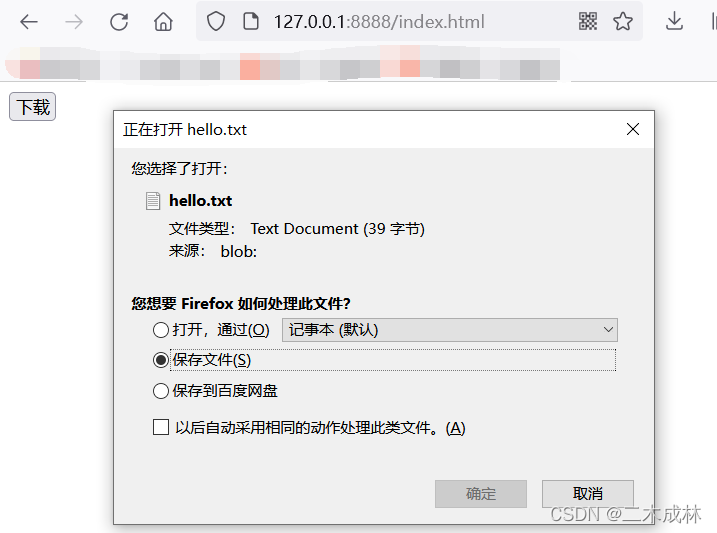Node.js下载文件
二木成林 人气:0第一种方式:使用原生的http模块
我们仅需要用到fs和http两个node.js的原生模块,不需要安装第三方模块,就可以实现文件的下载。代码如下:
var fs = require('fs');
var http = require("http");
var server = http.createServer();
server.on("request", function (request, response) {
// 获取请求URL
var url = request.url;
// 如果是下载文件的URL,则判断进行处理
if (url === '/download/hello.txt') {
// 提取文件名hello.txt
var name = url.substring(url.lastIndexOf('/'));
// 创建可读流,读取当前项目目录下的hello.txt文件
var rs = fs.createReadStream(__dirname + "/" + name);
// 设置响应请求头,200表示成功的状态码,headers表示设置的请求头
response.writeHead(200, {
'Content-Type': 'application/force-download',
'Content-Disposition': 'attachment; filename=' + name
});
// 将可读流传给响应对象response
rs.pipe(response);
}
});
server.listen(8888, function () {
console.log("服务器启动成功,可以通过 http://127.0.0.1:8888 来进行访问");
});
然后可以通过http://127.0.0.1:8888/download/hello.txt下载文件。

第二种方式:使用Express+Axios下载文件
前端通过axios发送GET或者POST请求来进行文件的下载,关键是对响应回来的文件数据进行处理。
index.html:前端页面,通过点击按钮来进行下载文件,而请求是通过axios来发送的。
<!DOCTYPE html>
<html lang="en">
<head>
<meta charset="UTF-8">
<!-- 引入axios.js -->
<script src="https://cdn.jsdelivr.net/npm/axios/dist/axios.min.js"></script>
</head>
<body>
<button onclick="downloadFile()">下载</button>
</body>
<script>
function downloadFile() {
axios({
url: '/file/download',
method: 'POST',
responseType: 'blob'
}).then(function (response) {
// 将响应回来的数据下载为文件,固定代码
// 将响应数据处理为Blob类型
var blob = new Blob([response.data]);
// 创建一个URL对象
var url = window.URL.createObjectURL(blob);
// 创建一个a标签
var a = document.createElement("a");
a.href = url;
a.download = "hello.txt";// 这里指定下载文件的文件名
a.click();
// 释放之前创建的URL对象
window.URL.revokeObjectURL(url);
}).catch(function (reason) {
console.log(reason)
})
}
</script>
</html>
index.js:使用express来渲染index.html页面,并且来处理下载请求。
var fs = require('fs');
var express = require('express');
var app = express();
// 渲染index.html,跟下载逻辑无关
app.get('/index.html', function (request, response) {
fs.readFile('index.html', function (err, data) {
if (!err) {
response.end(data);
}
});
});
// 处理下载文件的请求
app.post('/file/download', function (request, response) {
var name = "hello.txt";// 待下载的文件名
var path = __dirname + "/" + name;// 待下载文件的路径,指定为当前项目目录下的hello.txt文件
var f = fs.createReadStream(path);
response.writeHead(200, {
'Content-Type': 'application/force-download',
'Content-Disposition': 'attachment; filename=' + name
});
f.pipe(response);
});
// 监听端口,相当于原来的server.listen()
app.listen(8888, function () {
console.log("app is running at port 8888.");
});

又可以通过response.set()方法来设置响应头:
response.set({
'Content-Type': 'application/octet-stream',// 告诉浏览器这是一个二进制文件
'Content-Disposition': 'attachment; filename=' + name// 告诉浏览器这是一个需要下载的文件
});
总结
下载文件其实很简单,在哪种语言里都是这样:
第一步,设置响应头。第二步,返回数据流。
设置响应头
下载文件需要设置的响应头是Content-Type和Content-Disposition,响应头与编程语言无关,是通用的。
'Content-Type': 'application/octet-stream'表示这是一个二进制文件。
'Content-Disposition': 'attachment;filename=hello.txt'表示这是一个需要下载的附件,并且告诉浏览器默认文件名。
返回数据流
读取要下载的文件,以二进制流的形式响应给客户端。
加载全部内容